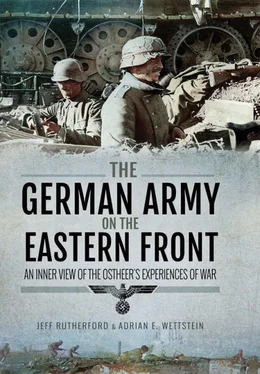Guidelines for the training of the Hilfswillige
1) The objective of the training and education of the Hilfswillige is to educate them to be reliable fellow combatants against Bolshevism.
2) In order to carry out that training and education, the Hilfswillige are to be appropriately concentrated in camps and suitable supervisory personnel and trainers (including interpreters) have to be made available. The following organization of the Hiwi replacement company has proven itself here in the camps: for every division one or more Hiwi replacement companies. Disposal of training personnel by the division in question. The training personnel train the Hilfswillige for their own division and assist with the allocation of the Hilfswillige inside the division.
3) […]
4) Sustainment of the commitment to service and willingness to fight against Bolshevism are important. In addition to a variety and variation in training, this will be achieved by the example and personality of the German superiors and their active care. Strict but fair treatment through an exact knowledge of the Russian mentality, the eradication of Bolshevik influence through systematic military-ideological leadership to educate the Hilfswilligen to a reliable fellow combatant for the troops. The belief in the absolute superiority of the German leadership and the German soldier over the Red Army and its members is to be stimulated and sustained.
5) […]
6) At every roll call, one has to pay attention to bearing and uniform.
Complementing this focus on developing an anti-communist attitude, the training – or rather education – aimed at a strict discipline. Of course this was needed, but the stressing of discipline here was also part of the German perception that Russian ‘subhumans’ had to be educated to discipline, as they inherently lacked this due to their ‘nature’. As with German replacements, Hilfswillige were trained in the division to which they were attached. With this decentralized organization, the German army again desired to achieve a rapid deployment, but it also wanted to give divisions control over the process of selection. The divisions thus had a keen interest in choosing those men since they would have to fight with them later. This made the selection of instructors especially important. These individuals had a difficult task, as they needed to educate Russians to become ‘reliable fellow combatants’, while at the same time convincing them of the ‘absolute superiority’ of the German military. This became more difficult after the defeat at Stalingrad, but nearly impossible from summer 1943 on, when German victories became very rare events. Even during the years of German defeat, many Hilfswillige and other Soviet auxiliaries stayed with their German units, though this was not so much out of conviction, but rather a consequence of the Stalinist policy that deemed these men as traitors and threatened them with severe punishment.
The main purpose of Hilfswillige was to free German soldiers for combat duty. How this was intended for various positions can be seen again in the orders of the OKH on the enhancement of combat power in autumn 1942: [20]
B) Replacement of the German soldier
Hilfswillige (prisoners of war) are to be employed in place of German soldiers:
In all units up to and including company and battery as a driver, co-driver, horse and mule-driver, craftsman, technical personnel (locksmith, weapon personnel, etc.) and as working personnel in construction and supply units.
In addition: as ammunition bearers in machine gun companies, infantry-gun companies and anti-tank companies.
In battalion and regimental staffs as cable carriers at telephone sections.
In batteries as gunner 5 and 6.
In engineer battalions as engineers not directly involved in the combat. Example:
Formation of a company from only German soldiers for combat deployment.
Formation of 2 further companies with German cadre, filled with Hilfswillige , for bridge building, road and quarters construction, mining and demining, obstacle construction.
In signal battalions in mixed telephone-construction groups.
For building units of all kinds. Only German supervisory staff (ratio 1:10) can be used here.
For supply troops of all kinds. In these, generally, only supervisory staff and the absolutely necessary specialists such as mechanics, bakers, butchers, etc. are to be left.
The purpose of these measures is to free German soldiers. It is not possible that Hilfswillige are hired additionally, just to do mindless work, and the baggage train is thus increased without gaining a German soldier. A sharp supervision is also necessary here!
Therefore, Hilfswillige were to fill all types of auxiliary service positions. While the requirements for most of these positions were low – and therefore could be brought in line with the Nazi ideological belief of Russians as primitive subhumans – the use of Hilfswillige in craftsman or mechanic positions blurred that line. Even when considering all of the boundaries drawn by the German military between German soldiers and Hilfswillige , one cannot escape the impression that in this question, military necessity overtook Nazi ideology. This became especially clear in the cases where Russian Hilfswillige fought side by side with German soldiers, prompting XIth Army Corps Chief of Staff, Oberst Helmuth Groscurth, to write: ‘It is disturbing that we are forced to strengthen our fighting troops with Russian prisoners of war, who are already being turned into gunners. It’s an odd state of affairs that the “beasts” we have been fighting against are now living with us in closest harmony.’ [21]However, even the most fanatical Nazi ideologue had to recognize from mid-1942 on that German troops in the east could not have fought without the help of hundreds of thousands of Soviet men and women serving in the German army and in other agencies, such as, for example, the Reichsbahn . Otherwise, the Germans would have had to mobilize the Reich’s manpower resources at a much higher level, an issue that was feared by Hitler and many other high-ranking German officials due to traumatic experience of the collapse of 1918. Because of this period of limited German mobilization from mid-1942 to summer 1944, Bernhard Kroener has written that it was ‘not quite total war’. [22]
Once German soldiers were freed, units needed to proceed in the following manner: [23]
C) Use of freed German soldiers
The following is to be done:
1) infantry (not the last-surviving sons or the physically unsuitable), whose present position will be filled in the future by Hilfswilligen , are a) if their training permits, to be immediately integrated in rifle companies, b) to be consolidated in training companies by the division and after sufficient training to be transferred to rifle companies. The divisions may, at their own discretion, also use members of other branches.
2) Soldiers of all other branches and supply troops, as well as the last-surviving sons and the physically non-suitable for infantry service, are to be registered by each division and are to be trained for winter and positional warfare. They are then available as reserves, which must suffice until spring, for the winter position.
The initial gain of these measures was rather small, as few soldiers could be directly placed into rifle units. Furthermore, these measures destroyed valuable cadres and necessitated the introduction or rebuilding from scratch of new companies and battalions, a demanding task that cost much blood. The units mentioned under point 2 often enough could not fulfil their task due to the lack of adequate training, equipment and especially leadership. They marked the bottom of a poor man’s army, often suffering extraordinary losses with minor military effect. The widespread forming of such alarm units in late 1942 was a clear sign of an army that had lost its balance.
Читать дальше






![John Stieber - Against the Odds - Survival on the Russian Front 1944-1945 [2nd Edition]](/books/405234/john-stieber-against-the-odds-survival-on-the-russian-front-1944-1945-2nd-edition-thumb.webp)





